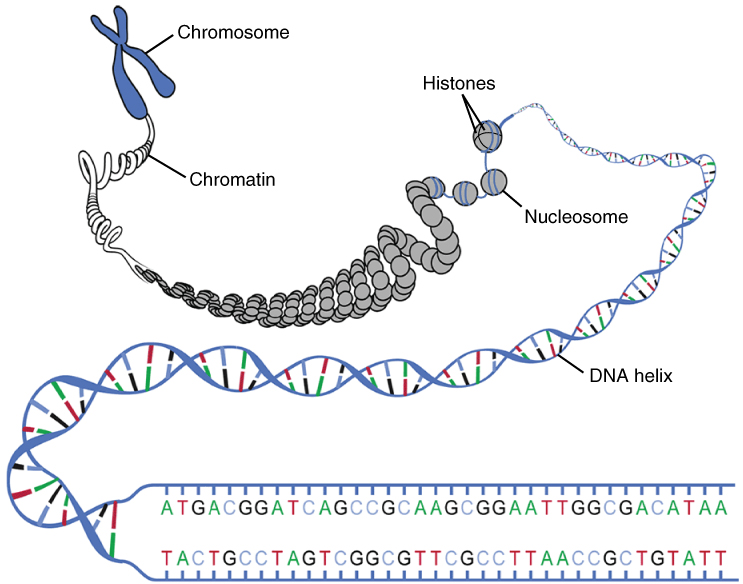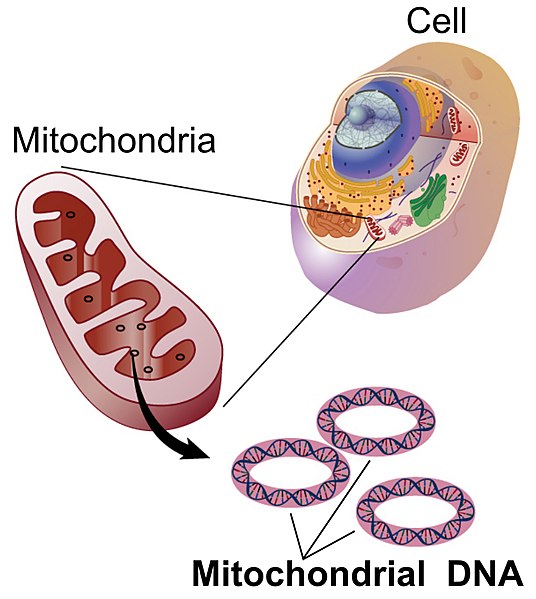With a new semester and familiar routines now underway, I found a few moments to reflect on one of my favorite science stories from last fall—a story that almost passed me by at the busy end of my academic semester. But this headline of an article by Carl Zimmer in the New York Times did catch my eye online: “Scientists Are Just Beginning to Understand Mysterious DNA Circles.” Likewise, ScienceDaily summed up the recent research characterizing “vicious circles” of DNA. Both articles described research published in November 2019 in the science journal Nature by a large cross-disciplinary team of scientists headed by Paul Mischel from the University of California at San Diego. So what’s the big excitement about?
Some cancer cells have unusual circles of DNA in them.
In general, the famous double helix molecule of DNA is very lengthy, made of building blocks called nucleotides that hook together in two chains that twist together like a spiral staircase. In many organisms (including humans), the DNA is coiled around scaffolding proteins called histones, to organize and store the DNA at various levels of compaction within a cell structure called the nucleus. The strategy is much like the one I use to manage my outdoor garden at my house: I can wrap the hose around a hose reel for compact but easily accessible storage next to my house. When I want to use the hose, I simply unwind it and stretch it out; when I’m finished, I wind it up and keep it from snaking over the yard all the time and getting tangled up or damaged by the lawn mower. DNA wrapped up around histones creates a material called chromatin. This organization allows cells to manage how DNA is stored and inherited as chromosomes, but also is made accessible to read out the genetic code and activate various programming elements (genes) when needed.

In some cancer cells, not all of the DNA is neatly stored as chromosome segments that are carefully managed and passed along from generation to generation in the traditional sense. Instead, some of the genes that can trigger cancerous changes in cells are stored in many duplicate copies on small circles of DNA separate from the regular chromosomes. The new insight from the team of scientists is a detailed characterization of these DNA circles, what genes are found there, and how tightly coiled the circles are. In general, there are more of these cancer-causing genes, and they aren’t coiled up and quiet. They’re very active and may lead to drastic changes in cell behavior such as the runaway cell growth that is a hallmark of many tumors.
There were plenty of big science stories in 2019, including the much celebrated first images of a black hole, and the ongoing ecological threats and social activism spurred by a changing climate. So why highlight a small story about potentially cancer-causing tiny DNA circles, even as we have moved on into 2020? I have a few reasons:
- I like thinking about DNA organization and behavior. In my research training, I looked at how DNA undergoes reorganization prior to cell division for sexual reproduction. The basics of mitosis and meiosis that most students learn in school have been well understood for over 100 years, but we don’t have all the details figured out. Even how DNA is stored in the nucleus is still an open question (see an earlier blog post for more on this topic).
- Even with all this background knowledge, I didn’t know that there can be DNA circles in human cells at all. I missed out on this new finding from a few years ago that the cancer researchers have been building on. I love learning new things, and this topic excited me with the way it re-examines how we think about DNA organization in complex cells, and also for its potential to help us think about the complex questions of cancer biology. I showed one of the microscopy images from the research report to my genetics students as we wrapped up our class and discussed with them how we think about new questions in biology.
- DNA circles are very important in other areas of biology. Bacteria, for example, are famous for having a single circular chromosome of DNA that is not housed in a nucleus. Many bacterial cells also contain small DNA circles outside the chromosome called plasmids, which they can pick up from the environment or from other cells. If these plasmids have useful genes, they can change the traits of the bacterial cell in potentially dramatic ways and enhance their survival. For example, a gene that allows a bacterial cell to resist being killed by a common antibiotic drug could be spread from cell to cell via a plasmid and save the life of many bacterial cells—to the detriment of the human patient taking the drug to kill off a harmful bacterial infection. When spread through the environment, these antibiotic resistance traits lower our global ability to fight off potentially deadly bacterial infections. Humans also engineer bacterial (and yeast) plasmids with genes of their choice to study the basic functions of genes from a wide range of species in a laboratory setting. Plasmids are also used in drug manufacturing, agriculture, and other areas of biotechnology. Perhaps the human DNA circles with cancer traits function in a similar way to bacterial plasmids, albeit with a more sophisticated structure. Time will tell, with more research.
- A few cellular compartments such as mitochondria and chloroplasts also have circular DNA inside them. These DNA circles are thought to be remnants of an evolutionary history from ancient microbes that managed energy in creative ways that benefitted the larger cells that engulfed them. Genes found in human mitochondrial DNA have been linked to metabolic traits and metabolic disease. Understanding how circles of DNA outside the standard chromosomes is teaching us a lot about how our traits are expressed, maintained, and shared.
- A few years ago, I first learned of small, circular RNA molecules—the chemical cousin of DNA that manages how DNA information is decoded and regulated in most cells. But the function of these circles remains poorly understood. Perhaps they regulate the more familiar linear RNA molecules, rather than DNA itself. All we know is that they remain somewhat mysterious, and that we hadn’t noticed them until a few years ago.
The story of cancer genes stored as circular DNA outside the chromosomes highlights an important lesson in science. Just when we think we understand a lot about a topic (like chromosomes)—or when we despair finding new angles on a difficult problem (like cancer)—we discover something new. Sometimes, these discoveries can get us closer to answering complex questions, such as “where does cancer come from?” At any rate, these discoveries can both keep us humble and provide new excitement to keep looking forward with curiosity through the often slowly incremental nature of scientific discovery. And so, whether we’re peering out at the distant depths of our universe or inward to the tiny molecules within our own bodies, we make new progress in building a more complete story of how the universe works. And there’s no time limit on that.

